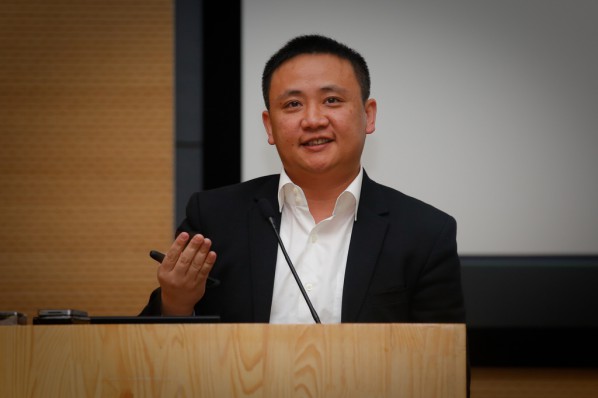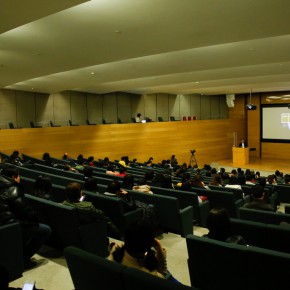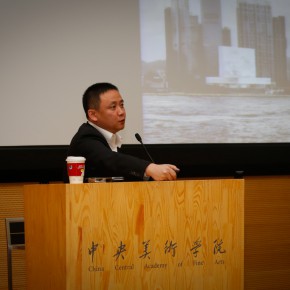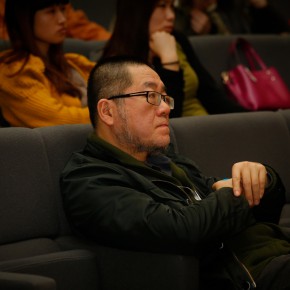
At 6:00 pm on March 3, 2014, session four of the 2nd CAFAM Biennale “Contemporary Curating” a series of lectures – “Pi Li: Curating, Collection, and Collection Strategies” was held at the Auditorium of CAFA Art Museum, and was presided over by Wang Chunchen, invited Pi Li, the famous Chinese curator and art critic, currently working at M + Museum in Hong Kong.
The content of the lecture is mainly on the collections and curating strategies of M+ Museum. Pi Li initially briefly introduced the background of M+ project. The government of Hong Kong designed to build M+ Museum in 1997, in 2007 the government earmarked 23 billion Hong Kong Dollars to support the building and operating of the museum. Chinese contemporary art collector Dr. Uli Sigg selected more than 1000 works from his huge collections, and donated them to M+ Museum in Hong Kong which will be completed in 2007. The museum is still in the preparation stage, mainly engaging in the collection, human resources, and the construction of the audience. Pi Li said, they were facing some problems: firstly, because it was supported by the government, it had to undergo a cumbersome process of decision, the implementation was slow; secondly, how to establish a collection in a short time; thirdly, the style of display and exhibition...
M + Museum focused on the works of the 20th century and the 21st century, from the current perspective of Hong Kong in cooperation with the international vision. As a museum of visual art, M + renders a variety of art forms, including ink painting, printmaking, photography, architecture, design, and moving images. And it showcases the ink work which is different from the traditional ink, more emphasis on the connection between ink and contemporary art, and how to transform ink into contemporary. For example, the museum collects the works by Yang Jiechang and the Kowloon Emperor. In addition, M + focuses on the combination of contemporary and popular culture, as it will be a new formal art museum, rather than a traditional museum in our mind, compared with an art center, it has collections, compared with a museum, its category is more diverse, in the museum people can see how the so-called cultural creations affect our daily life. Pi Li believed that the same work can be displayed from different perspectives, such as Yang Fudong’s “The Seven Sages of the Bamboo Grove” by Yang Fudong, were not only displayed in the form of video, the scenes in the film were also the valuable materials of architecture. In M +, film, design, and architecture were not separated.
It is worth mentioning that Pi Li also emphasized the form of the exhibition through the collection in order to tell a story. In 1979 through to 1989, the stories about Maryn Varbanov and his wife, as well as the Maxim Restaurant, were greatly restored and displayed using literature and artworks. It included all the visual cultural factors, applying Hong Kong’s narrative to slowly tell the story to the audience.
Thus we can see that the M + doesn’t apply a clue to restore the artworks, but from the perspective of social relationships to render the works and the stories behind the art work on multi levels. As Pi Li said, the audience was given a mess instead of a line. The audience draws out a line from the mess entirely depending on his or her choice.
The works donated by Sigg were mainly created in 1974 going through to 2010, based on which M + draws the context of art history in the late 20th century as far as possible, and adds some other related clues from time to time. For example, there were few works of conceptual art in “’85 New Wave” from the donations by Sigg, so M+ supplied it through “Guangdong Express” from the donation by Guan Yi. In the future, M + aims to be the authoritive base for Eastern artists to showcase their works, as well as home for overseas Chinese artists’ works. On this basis, the exhibits cover other Asian regions, and records the relationships between Asia and the artistic trends from North America and Europe.
It was a mixture of disapproval and praise in social public opinion and academia since M+ was organized, but no matter how, this project was a great discovery, which witnessed the determination of Hong Kong to grow the career of the museum as well as to lay a solid foundation for local culture.
Q&A
What is the standard and condition of donations?Pi Li: The procedure for us to accept donations is in line with the purchase, we select the donations that we need. We will think of it from the perspective of an exhibition, maintenance cost, and permanent display, etc. so that we seriously deal with donations. As for the condition, it mainly depends on donors and their different conditions.
Journalist: Zhang Gaoshan, translated by Chen Peihua and edited by Sue/CAFA ART INFO
Photo: Dong Huiping and Quan Jing/ CAFA Art Museum


































